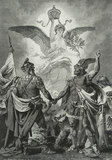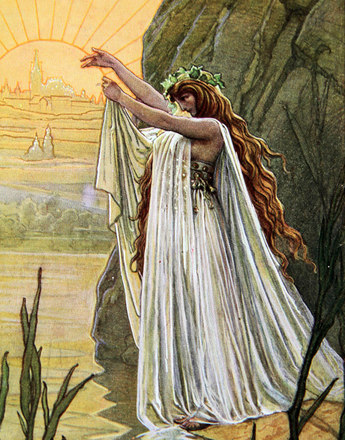-

“German unification”. Based on a painting by A. von Werner
Copyright: Schloß Schönbrunn Kultur-und Betriebsges.m.b.H./Fotograf: Alexander E. Koller
Partner: Schloß Schönbrunn Kultur- und Betriebsges.m.b.H. -

Germania: Column on the Niederwald monument, illustration, around 1900
Copyright: Schloß Schönbrunn Kultur-und Betriebsges.m.b.H./Fotograf: Alexander E. Koller
Through Emperor Franz II’s dissolution of the Holy Roman Empire in 1806 the German-speaking lands lost a structure that had been an important, if symbolic, source of cohesion and unity.
At the time the Holy Roman Empire came to an end, the German-speaking world was made up of a multitude of small or middle-sized states. Although Austria and Prussia were the leading powers, both had territories and interests outside the Empire, with the population of the Habsburg lands in particular including a large and important proportion of other ethnic groups. As a result, the two leading German states did not see themselves as German nation-states but as dynastic monarchies.
At that time German identity only existed in a somewhat basic and symbolic form. While the fact of the common language was the foundation for a vague feeling of belonging together, for the vast mass of Germans this was less important than an identity deriving from belonging to a particular region or principality. Territorial unification was made impossible by the fact that some German areas of settlement, particularly in the east, had ill-defined borders and were ethnically mixed. Consequently, the territorial perspective was a separate matter from the early idea of a ‘German cultural nation’, according to which the German nation was present ‘wherever the German tongue is heard’ (Humboldt).
As a relatively highly developed codified literary language, German enjoyed a primacy that was still uncontested even in areas where the majority of the population did not have German as their mother tongue. As a result the Germans did not have to go through the kind of cultural rebirth or processes of linguistic reawakening that the other language groups of Central Europe did.
France played a catalytic role in the German rise to nationhood. Initially France’s claim to cultural hegemony over seventeenth- and eighteenth-century Europe had aroused antipathy amongst Germans; when catalyzed by Napoleonic expansionism, anti-French feeling developed into a veritable ideology of liberation.
The birth of the German nation in the modern sense of the word dates back to the Congress of Vienna (1814/15), which resulted in the foundation of the German Confederation – a hybrid association of states with a long-term potential for being transformed into a federal state. Underlying the concept of the German Confederation was the desire to carry on the tradition of the only recently dissolved Holy Roman Empire, which was now idealized and glorified as the medieval forerunner of a German nation-state. At this stage the term ‘German’ underwent a change in meaning: having hitherto been understood only in an historical and political sense, it now acquired an ethnic and national dimension.
In 1817 the German national movement experienced its first landmark event in the Festival on the Wartburg, a meeting of student fraternities which combined the demand for liberalism and political freedoms with a call for national unification. At the same time they endorsed extremism and political violence as ultimate means for achieving their ‘sublime ideal’.
This period also saw the creation of the symbols that were to become standard parts of the German national movement. ‘Die Wacht am Rhein’ (‘The Watch at the Rhine’) became the inofficial anthem of the unification movement, whose members wore the German tricolor of black, red and gold derived from the uniforms of the Lützow volunteer force that had fought against the French occupation during the Napoleonic wars.
Translation: Peter John Nicholson
Doering-Manteuffel, Anselm: Die deutsche Frage und das europäische Staatensystem 1815 bis 1871 (Enzyklopädie deutscher Geschichte 15), München 1993
Rumpler, Helmut: Eine Chance für Mitteleuropa. Bürgerliche Emanzipation und Staatsverfall in der Habsburgermonarchie [Österreichische Geschichte 1804–1914, hrsg. von Herwig Wolfram], Wien 2005
-
Chapters
- The German-Austrians in the Habsburg Monarchy
- German Austrians or Austrian Germans?
- Holding the Monarchy together: The German-Austrians as the guarantors of Habsburg statehood
- In search of the Fatherland: The genesis of the German nation
- To join or not to join? Austria and the process of German unification
- Fear of losing hegemony: The German-Austrians in the Austrian multi-national state
- The radical German nationalists and their attitude to the Habsburg Monarchy
- The concept of ‘German Central Europe’




